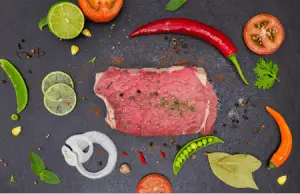
Camping outdoors is one of those activities that makes a seasonal break complete. It’s always fun, regardless if you haul a pop-up canopy, a hammock, or a tent, so long as food’s there.
The only concern of new health-conscious campers, however, is that there are limited meal options outdoors. In truth, it just seems like it because many prefer to bring chips and canned beverages during a camping trip. But it does not mean that you have to follow suit and forget your food principles.
Hence, let me shed some light on how to keep eating healthy in the wild today.
What can you do to ensure you’re eating right outdoors?
How to keep eating healthy out there isn’t rocket science. You can do it once you do the following:
Begin with a smart strategy.
 You should spend some time planning the foods and beverages that you will bring in the campsite.
You should spend some time planning the foods and beverages that you will bring in the campsite.
A wise strategy is to include lightweight foodstuff in the bag, in case you are going solo. It will allow you to take extra gears without huffing and puffing along the way. Having plenty of water can’t be amiss either, even though you may want to carry juices and other drinks too.
Pack at least a day before.
Nothing astounding comes out of being a procrastinator and preparing your backpack a few hours before the trip. It is vital to do so prior to that, so you can obtain all the missing items from the supermarket. The homemade side dishes or cold meals that you intend to transport can also remain as fresh as possible.
Go for non-perishable foods.
How easy can your camping experience be when you only have nuts, granola bars, and canned goods to worry about? These non-perishable products are still healthy and full of nutrients, so they can keep your stomach satiated.
If you wish to have fruits and vegetables on the table, you may carry them in dried or freeze-dried forms. It can’t be too difficult to process such produces, especially when it entails that they won’t deteriorate and become inedible. Should you not have the luxury to pencil this work in your schedule, the local grocery store may have some ready for you.
Manage food preparation with care.
The germs spoil not just the foodstuffs but also your chances to keep eating healthy in the wild. For this reason, you should practice how to handle the former properly.
One practical rule of thumb is to never touch food without washing your hands first. It will be cool if you stake your tent near a creek or river so that you can clean up there. If a body of water isn’t available, wet wipes will do fine as well.
For a non-vegetarian, the plate you use for the raw meat should be different from where you place the cooked pieces. This way, it isn’t impossible to prevent the microbes from transferring to the latter.
Is a cooler necessary?
To be honest, the answer can be a yes or a no. A chiller is not required, considering it is winter and you don’t plan on bringing steaks and perishable products. A portable cooler comes in handy, on the contrary, once the warm weather cannot maintain foods at a low temperature.
The trick to ensuring that the cool box can perform its job well is to separate the beverages from the foodstuff. You will most likely open the container for the drinks often; that’s why the coldness in there can’t be maintained. It’s alright for fluids, but not for raw and chilled foods, so you need to put them in diverse spaces.
In case the campsite isn’t very far from the town where there are stores, you can also restock the ice. Doing so will help you decrease the heat inside the cooler. Thus, you will be able to sustain the freshness of the items you store in it.
What else should you think about to keep eating healthy while camping?
The advice-giving session is far from over. Here are a few more tips that you may find useful in the wild:
Take care of the meat well.
 Grilling meat is the high of your adventure, so you shouldn’t miss out on it. Despite that, isolate the raw cuts beforehand to stop the germs that may be stuck on them from infecting others. Rather than leaving the pieces out in the open to thaw, it’s better to move them in a warmer cooler.
Grilling meat is the high of your adventure, so you shouldn’t miss out on it. Despite that, isolate the raw cuts beforehand to stop the germs that may be stuck on them from infecting others. Rather than leaving the pieces out in the open to thaw, it’s better to move them in a warmer cooler.
Wash fruits and veggies in running water.
Simply dropping the fresh produces in a bowl of water cannot clean them thoroughly. You should allow water to run over them instead to ascertain that the fluids will flush away the bacteria. In case there is no tap or natural body of water in site, the bottled one you’ve brought is okay.
Consume cold dishes immediately.
The mayonnaise-based foods that you’ve prepared prior to the trip should always remain in the chiller to avoid spoilage. Take them out once you’re ready to dig in. But, please, remind yourself that their shelf life at room temperature only lasts for two hours, so finish them fast.
Take filling food varieties.
Camping sometimes denotes hiking and climbing; that’s why you may feel hungry more often than when you’re in the city. Due to that, you must bring foodstuff that has enough protein and good carbohydrates to replenish your energy.
In Conclusion
The shelf life of your food outdoors heavily relies on how you prepare them beforehand. A cooler is not an absolute necessity, in case you only plan to stay there overnight. It becomes essential, though – along with proper food-handling methods – when you decide to extend the trip.
You can then keep eating healthy in the wild once you heed the suggestions written above.
Good luck!

